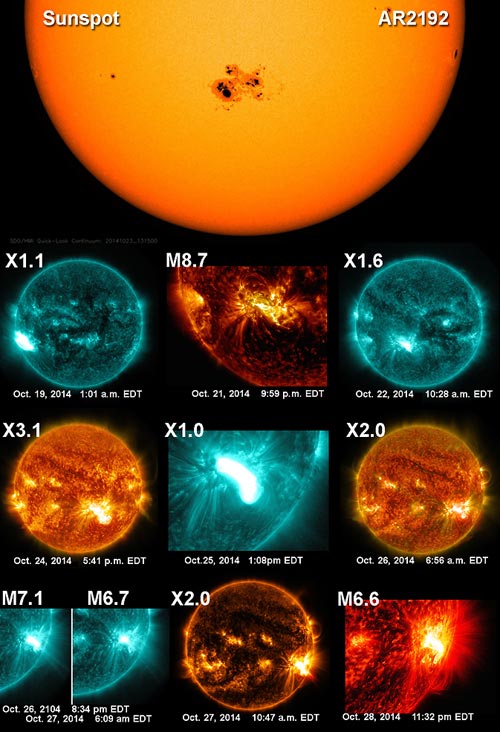Tracking a Gigantic Sunspot Across the Sun

Super sunspot AR2192 produced 10 significant solar flare while traversing the Earth-side of the sun; six X-class and four above M5-class. Image Credit: NASA/SDO
“Despite all the flares, this region did not produce any significant coronal mass ejections,” said Alex Young a solar scientist at NASA's Goddard Space Flight Center in Greenbelt, Maryland. Coronal mass ejections, or CMEs, are giant clouds of solar particles that can affect technology when they reach near-Earth space.
“You certainly can have flares without CMEs and vice versa, but most big flares do have CMEs. So we're learning that a big active region doesn't always equal the biggest events.”
Such active regions are measured in millionths of a solar hemisphere, where 1 micro-hemisphere, or MH, is about 600,000 square miles. This region topped out at 2,750 MH, making it the 33rd largest region out of approximately 32,000 active regions that have been tracked and measured since 1874. It is the largest sunspot seen since AR 6368, which measured 3,080 MH on Nov. 18, 1990.
The largest five active regions ever observed were between 4,000 and more than 6,000 MH and they all appeared between 1946 and 1951.
On the other hand, the region that produced one of the biggest solar flares of all time on Sep. 1, 1859 – in what's known as the Carrington event – wasn't even one of the top 50 at only 2,300 MH.
During its trip across the front of the sun, AR 12192 produced six X-class flares, which are the largest flares, and four strong M-class flares. M-class flares are one tenth as strong as X-class flares. The number provides more information about its strength. An M2 is twice as intense as an M1, an M3 is three times as intense, etc.
“Having so many similar flares from the same active region will be a nice case study for people who work on predicting solar flares,” said Dean Pesnell, project scientist for NASA's Solar Dynamics Observatory at Goddard. “This is important for one day improving the nation's ability to forecast space weather and protect technology and astronauts in space.”
The dates and peak times in EDT of the large solar flares from AR 12192 are as follows:
Oct. 19, 1:01 am: X1.1
Oct. 21, 9:59 pm: M8.7
Oct. 22, 10:28 am: X1.6
Oct. 24, 5:41 pm: X3.1
Oct. 25, 1:08 pm: X1.0
Oct. 26, 6:56 am: X2.0
Oct. 26, 8:34 pm: M7.1
Oct. 27, 6:09 am: M6.7
Oct. 27, 10:47 am: X2.0
Oct. 28, 11:32 pm: M6.6
AR 12192 rotated onto the far side of the sun on Oct. 30, 2014, however as it evolves, we may see a new version of it rotating back into view in two weeks.
Related Links:
For more on this gigantic sunspot and its flares:
> http://www.nasa.gov/content/goddard/sdo-observes-largest-sunspot-of-the-solar-cycle/
> http://www.nasa.gov/content/goddard/sdo-observes-more-flares-erupting-from-giant-sunspot/
> http://www.nasa.gov/content/goddard/one-giant-sunspot-6-substantial-flares/
> http://www.nasa.gov/content/goddard/oct-22-2014-third-substantial-solar-flare-in-2-days/
> http://www.nasa.gov/content/goddard/sdo-observes-an-x-class-solar-flare/
> Sunspot AR2192 Flare Family Portrait
> Sunspot AR2192 Flare Family Portrait – Unlabeled
> Download high resolution media from Oct. 24, 2014
> Download high resolution media from Oct. 22, 2014
> What does it take to be X-class?
Karen C. Fox
NASA's Goddard Space Flight Center, Greenbelt, Md.
Media Contact
All latest news from the category: Physics and Astronomy
This area deals with the fundamental laws and building blocks of nature and how they interact, the properties and the behavior of matter, and research into space and time and their structures.
innovations-report provides in-depth reports and articles on subjects such as astrophysics, laser technologies, nuclear, quantum, particle and solid-state physics, nanotechnologies, planetary research and findings (Mars, Venus) and developments related to the Hubble Telescope.
Newest articles

Superradiant atoms could push the boundaries of how precisely time can be measured
Superradiant atoms can help us measure time more precisely than ever. In a new study, researchers from the University of Copenhagen present a new method for measuring the time interval,…

Ion thermoelectric conversion devices for near room temperature
The electrode sheet of the thermoelectric device consists of ionic hydrogel, which is sandwiched between the electrodes to form, and the Prussian blue on the electrode undergoes a redox reaction…

Zap Energy achieves 37-million-degree temperatures in a compact device
New publication reports record electron temperatures for a small-scale, sheared-flow-stabilized Z-pinch fusion device. In the nine decades since humans first produced fusion reactions, only a few fusion technologies have demonstrated…





















